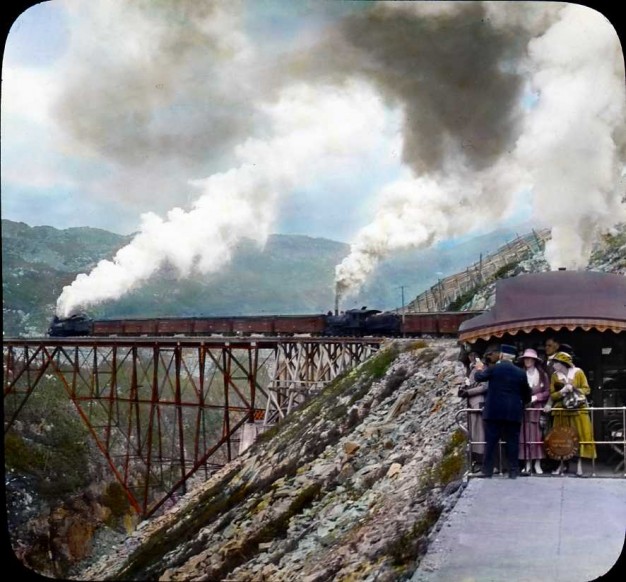Railroading to the Klondike
The Klondike Gold Rush lasted from August 1896 to August 1899. During that time an estimated 100,000 people, mostly men, tried to reach the gold fields by foot, horseback, and boat—mostly by foot and boat, as draft animals were difficult to maintain in the harsh conditions. A railroad would help in many ways. Thus was born the White Pass & Yukon Route (WP & YR) railroad. Construction started in May 1898, reached Lake Bennett by 1899, where prospectors could take water transportation to the gold fields, then the railroad went to Carcross, and above Carcross to Whitehorse, the territorial capital, where it was still a 300 mile trip down the Yukon River to the center of the gold fields in Dawson City.
The Klondike and its railroad were well-known to the public and, like so many far-off places, drew photographers and armchair sightseers who could vicariously enjoy visiting. Glass lantern slides—large transparencies mounted in a frame and projected on a screen—were popular at this time.
In 2018 the APS purchased a set of lantern slides showing a trip up the WP & YR. Color photography was not widely available, but black and white images could be taken and hand colored, as are the 47 slides the APS acquired.

The “trip” begins in Alert Bay, British Columbia, with slides of totem poles. The trip stops at Juneau, Alaska, where pictures of the Taku Glacier were taken, as were some for a jaunt to Atlin, BC; slides show gold mining activities in that area. Further up the coast is Skagway, AK, the jumping off point for most Klondikers and where the railroad starts. A few slides, such as the interior of a comfortable house, show how civilized the frontier town has become. Then, the railway journey begins, going up White Pass past remnants of the glory years. One slide has the grave of Jefferson “Soapy” Smith, enterprising con man and gang leader of Skagway who was killed in a shoot-out. His death removed one of the obstacles to building the railroad. After mountain scenes, the journey ends in Carcross, where the steamboat Tutshi could take a tourist on an excursion on the local lakes.

The WP & YR reached its full length after gold fever had passed its peak but served as a freight, passenger, and ore carrier (mostly silver, copper, and lead) until 1982. One can still ride the lower portion today as an excursion train.

The date the slides were made is uncertain, perhaps in 1918 to promote tourism after the War. Perhaps they were commissioned by the WP & YR. Most of the slides have the name Scott Slide Company of New York on them. John Scott and Edward Van Altena ran a successful lantern slide company specializing in “illustrated song” slides by which people could read words of popular songs and sing along. It is unclear if the company of Scott and Van Altena produced these slides, which join the hundreds of others already in the collection.


